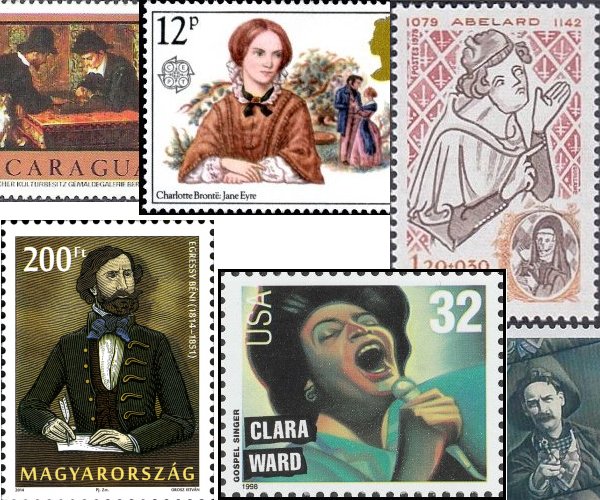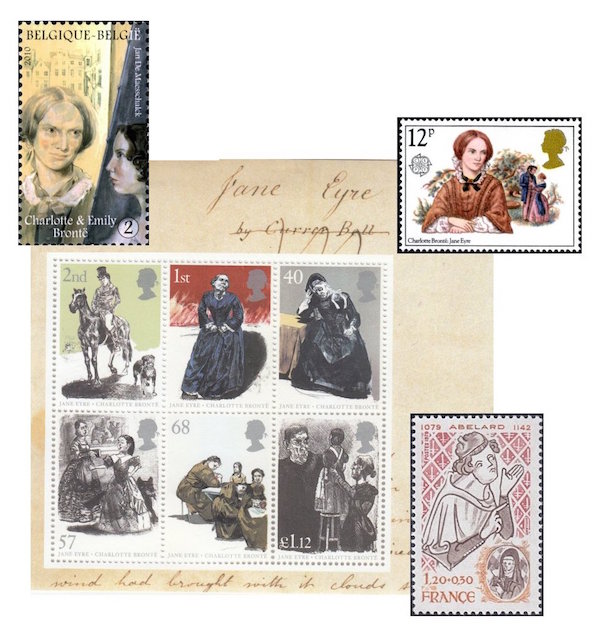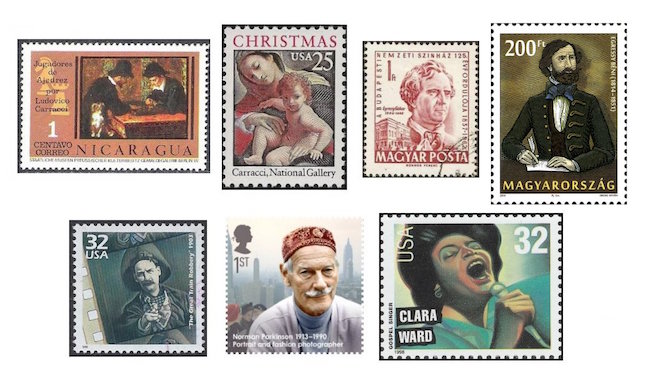The Arts on the Stamps of the World — April 21
An Arts Fuse regular feature: the arts on stamps of the world.

By Doug Briscoe
Queen of the Hill on today’s Arts on Stamps of the World is Charlotte Brontë, whose bicentenary was last year (21 April 1816 – 31 March 1855). Jane Eyre has seen its way to the operatic and balletic stage in a number of instances, all within the last quarter century. English composers John Joubert and Michael Berkeley each wrote his own opera in 1997 and 2000 respectively, and a ballet by Julia Gomelskaya was performed in 1994. Another ballet, called simply Jane, set to music by Max Reger (!) appeared in 2007. There’s also a Jane Eyre Symphony (his 7th) from 2009 by French composer Michel Bosc. I came across an interesting article online called “Music and the Brontës” by Philip Scowcroft. You can find it here if you scroll down from the big header. The British sheet of six Jane Eyre stamps came out back in 2005.
Beyond his reputation as a brilliant theologian and a jolly thriving wooer, Peter Abelard, who died on this date in 1142, was also a poet and composer, and not only of love songs (all of which are now lost): he also composed a book of hymns and six medieval laments (planctus). The stamp, naturellement, shows him with his beloved Héloïse.
Our recent spate of early Italian artists continues apace with Ludovico Carracci (21 April 1555 – 13 November 1619), who was the cousin of Annibale and Agostino Carracci, all active in Bologna. All three have their paintings reproduced on stamps, with Ludovico’s Chess Players among a set of Nicaraguan stamps from 1976 and a detail from his Dream of Saint Catherine of Alexandria (c1593) chosen for a 1988 US Christmas stamp. (Saint Catherine has been cropped from the Madonna and Child pair that is the focus of the Christmas theme.)

Better known as an actor in his day, Béni Egressy (BAY-nee EGG-reh-she; born Benjámin Galambos—BEN-yah-min GAW-lom-bosh—on this date in 1814) was also a librettist, translator, and composer. He took part in the revolution of 1848 and after receiving amnesty resumed working on the stage. He wrote the libretto (after a play by Lorinc Tóth) for Hungary’s national opera Hunyadi László by Ferenc Erkel. He also composed the music for “The Szózat”, set in 1840 to a beloved poem by Mihály Vörösmarty. This became a sort of unofficial Hungarian national anthem, upon which Franz Liszt wrote a ten-minute orchestral elaboration, “Szózat und Hymnus” in the early 1870s. Egressy died on 17 July 1851.
One of the pioneers of American film, as producer, director, cinematographer, and studio manager, was Edwin S. Porter (April 21, 1870 – April 30, 1941), probably most famous as the creator of the classic very early silent The Great Train Robbery (1903, see the stamp). He made more than 250 other films besides, including Jack and the Beanstalk (1902), Life of an American Fireman (1903), and The Prisoner of Zenda (1913). Interested in electricity from his youth, Porter shared a patent for a lamp regulator when he was 21 and continued inventing while working in the electrical department of a Philadelphia ship building company. He got in on the ground floor of the motion picture business in 1896 and traveled throughout the Caribbean and South America as a projectionist. He began making his own films while working for Edison. Porter was one of the first to use dissolves rather than simple cuts between scenes, but although he was constantly innovating in his successive projects he avoided carrying the same techniques over from one film to the next.
Norman Parkinson was born in the year Porter made The Prisoner of Zenda (1913). He worked with photography from the age of eighteen, doing work for Harper’s Bazaar in the late 30s and serving as an RAF reconnaissance photographer during World War II. After the war he was a portrait and fashion photographer for Vogue. In 1980 he succeeded Cecil Beaton as photographer of the Royal Family. He died on 15 February 1990 and was honored on a British postage stamp in 2013.

American gospel singer Clara Ward (April 21, 1924 – January 16, 1973) toured from her teens with her mother’s group the Ward Singers (aka The Consecrated Gospel Singers, The Ward Trio, The Famous Ward Singers, etc.). Having been joined by Marion Williams in 1947, the group started making recordings the next year. They appeared on the new medium of television and, in 1950, at Carnegie Hall with Mahalia Jackson and others. After the last avatar of the Singers disbanded, Clara was one of the first gospel singers to perform on Broadway and the first to sing with a full symphony orchestra.
Actors Anthony Quinn and Silvana Mangano, the brilliant Elaine May, and Rumpole of the Bailey author John Mortimer were all born on April 21 and all remain in the wilderness philatelically speaking.
A graduate of the University of Massachusetts with a B.A. in English, Doug Briscoe worked in Boston classical music radio, at WCRB, WGBH, and WBUR, for about 25 years, beginning in 1977. He has the curious distinction of having succeeded Robert J. Lurtsema twice, first as host of WGBH’s weekday morning classical music program in 1993, then as host of the weekend program when Robert J.’s health failed in 2000. Doug also wrote liner notes for several of the late Gunther Schuller’s GM Recordings releases as well as program notes for the Boston Classical Orchestra. For the past few years he’s been posting a Facebook “blog” of classical music on stamps of the world, which has now been expanded to encompass all the arts for The Arts Fuse.
